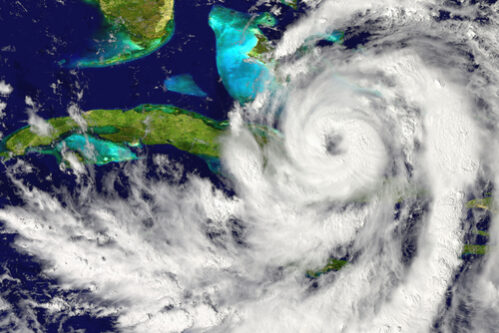While we can’t stop a hurricane or even fully fathom the destruction they cause, SOME OF YOU may be wondering — where do the bugs and birds go in such a big storm? It seems the birds and bugs in the eye of the hurricane could be a common occurrence.
Many of us know that Hurricanes are humongous tropical storms that can span a distance of 600 miles or more. There’s one part of a hurricane where things are quite different, though. It’s called the eye, and it usually exists in the center of a hurricane. The eye can vary greatly in terms of both shape and size. The eye of a hurricane is often circular or oval in shape. This may be why it’s called an eye, since it’s shaped somewhat like a human eye.
A hurricane’s eye can be as small as only a couple of miles wide. Most hurricane eyes, however, range in size from 20 miles wide to more than 60 miles wide. Unlike the raging winds that exist throughout the rest of a hurricane, inside the eye it’s mostly calm. The peaceful, light winds within the eye contrast severely with the winds that make up the edges, known as the eyewall. The winds in the eyewall are usually the most severe and destructive winds in the entire hurricane. Birds and bugs are often seen in the eye of a hurricane and for pretty understandable reasons. When they start getting caught up in whipping winds, they naturally move to where there is some calm. It just so happens in a hurricane, this is the eye of the storm. Hurricanes are not only devastating to humans but also to wildlife. Large storms can accidentally release invasive species, eliminate food sources, and strand aquatic species on land if they get stuck in a storm surge.
Although the eye of a hurricane sounds like a not-so-bad place to be, experts warn that you should always stay inside a sturdy building during a hurricane, even if you think it’s over. Since you never know when the eye will pass by, you wouldn’t want to get caught in the destructive winds of the eyewall. Let’s all hope that we escape any more destruction this hurricane season! If you want to offer support for restoration efforts in Texas and Florida, severely damaged by Hurricane’s Harvey and Irma, consider donating at give.salvationarmyusa.org
 The states that have been recently affected by hurricanes were left with a great deal of flooding. Standing water and still warm weather makes for the ideal breeding ground for mosquitoes. Based on experience following Hurricane Katrina, there will be several competing effects on the population of mosquitoes and the prevalence of arboviruses, such as Zika, dengue and West Nile, that they transmit.
The states that have been recently affected by hurricanes were left with a great deal of flooding. Standing water and still warm weather makes for the ideal breeding ground for mosquitoes. Based on experience following Hurricane Katrina, there will be several competing effects on the population of mosquitoes and the prevalence of arboviruses, such as Zika, dengue and West Nile, that they transmit.
Mosquitoes need stagnant water to lay eggs. Winds and floods will wash away containers that would have been breeding pools, but once the floodwaters recede, mosquitoes will recover. In 2006, a year after Katrina, Tulane University public-health experts reported that cases of West Nile infection increased more than twofold in communities that had been in that hurricane’s path. The study authors suggested that increased exposure was the culprit. Fleeing partially submerged buildings, people spent days outside waiting for rescue. Without air conditioning or dry spaces, Texans and Floridians may find themselves outdoors, too.
If Virginia sees more rain from the hurricane season before temperatures drop, we may very well see an extension of mosquito season as well.
CONTACT Holistic Pest Solutions to learn more about our mosquito treatment plans or give us a call at 434 842 1700. Whether you’re in Charlottesville, Waynesboro, or close by to either, Holistic Pest Solutions has the perfect plan for you that is as Green As You Wanna Be!
*Our Environmental Commitment: Holistic Pest Solutions is committed to the preservation of our environment. Our goal is to nurture the soils and plant life of lawns and landscapes. Utilizing holistic pest control practices that cause the least amount of impact on the environment.







